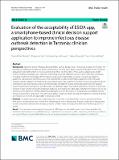| dc.description.abstract | Background
Epidemic-prone infectious diseases (EPIDs) such as dengue fever, coronavirus disease 2019 (COVID-19), leptospirosis, Marburg virus disease, measles and cholera, to name a few, place a significant burden on the Tanzanian population and health system. Clinicians working in primary health facilities (PHFs), such as dispensaries, health centres, and basic hospitals, play a vital role in detecting cases and outbreaks. However, they often face challenges, including insufficient knowledge of these diseases and a lack of supporting resources, including surveillance guidelines, standard case definitions, and, most importantly, access to confirmatory diagnostic tests. Although Tanzania reports outbreaks of infectious diseases almost every year, a significant number of cases go undetected and contribute to delayed response and recurrent outbreaks. Smartphone-based clinical diagnostic decision support systems (CDSS) have been proven to help bridge case detection gaps. The Epidemiological Surveillance for Infectious Diseases in Sub-Saharan Africa (ESIDA) project proposed developing the ESIDA app, a smartphone-based CDSS, to aid clinicians in the detection of EPIDs. Before developing the app, the ESIDA project evaluated its acceptability among clinicians, the primary target users. The aim was to gather insights to inform the app development, ensuring its design and features are relevant and applicable in Tanzania context.
Methods
In-depth interviews were conducted with 21 clinicians, including medical doctors and clinical officers from public and private facilities in the Dar es Salaam region, which has reported frequent outbreaks of dengue and cholera. Data were collected and analyzed using the Unified Theory of Acceptance and Use of Technology (UTAUT) model.
Result
Clinicians were positive about the proposed ESIDA app and intended to use it once it was available. The facilitators and barriers to acceptability focused on performance expectancy, effort expectancy, facilitating conditions and social influence. Expected benefits, ease of use, and government involvement emerged as facilitators of acceptability, while high internet costs, workload, time constraints, infrastructure gaps, and patient resistance were identified as potential barriers.
Conclusion
The development of the ESIDA app should prioritize maximizing system performance and benefits. They must also be user-friendly and in line with social norms. The necessary infrastructure must be in place for effective implementation. | en_US |

